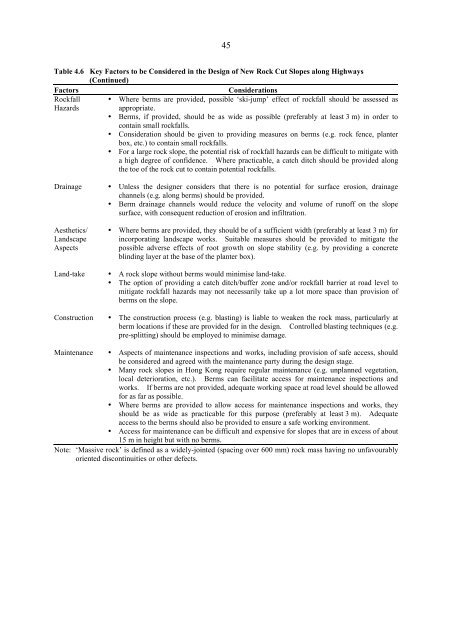Highway Slope Manual
Highway Slope Manual
Highway Slope Manual
You also want an ePaper? Increase the reach of your titles
YUMPU automatically turns print PDFs into web optimized ePapers that Google loves.
45<br />
Table 4.6 Key Factors to be Considered in the Design of New Rock Cut <strong>Slope</strong>s along <strong>Highway</strong>s<br />
Continued<br />
Factors<br />
Considerations<br />
Rockfall • Where berms are provided, possible ‘ski-jump' effect of rockfall should be assessed as<br />
Hazards<br />
appropriate.<br />
• Berms, if provided, should be as wide as possible (preferably at least 3 m) in order to<br />
contain small rockfalls.<br />
• Consideration should be given to providing measures on berms (e.g. rock fence, planter<br />
box, etc.) to contain small rockfalls.<br />
• For a large rock slope, the potential risk of rockfall hazards can be difficult to mitigate with<br />
a high degree of confidence. Where practicable, a catch ditch should be provided along<br />
the toe of the rock cut to contain potential rockfalls.<br />
Drainage • nless the designer considers that there is no potential for surface erosion, drainage<br />
channels (e.g. along berms) should be provided.<br />
• Berm drainage channels would reduce the velocity and volume of runoff on the slope<br />
surface, with consequent reduction of erosion and infiltration.<br />
Aesthetics/ • Where berms are provided, they should be of a sufficient width (preferably at least 3 m) for<br />
Landscape incorporating landscape works. Suitable measures should be provided to mitigate the<br />
Aspects<br />
possible adverse effects of root growth on slope stability (e.g. by providing a concrete<br />
blinding layer at the base of the planter box).<br />
Land-take • A rock slope without berms would minimise land-take.<br />
• The option of providing a catch ditch/buffer zone and/or rockfall barrier at road level to<br />
mitigate rockfall hazards may not necessarily take up a lot more space than provision of<br />
berms on the slope.<br />
Construction • The construction process (e.g. blasting) is liable to weaken the rock mass, particularly at<br />
berm locations if these are provided for in the design. Controlled blasting techniques (e.g.<br />
pre-splitting) should be employed to minimise damage.<br />
Maintenance • Aspects of maintenance inspections and works, including provision of safe access, should<br />
be considered and agreed with the maintenance party during the design stage.<br />
• Many rock slopes in Hong Kong require regular maintenance (e.g. unplanned vegetation,<br />
local deterioration, etc.). Berms can facilitate access for maintenance inspections and<br />
works. If berms are not provided, adequate working space at road level should be allowed<br />
for as far as possible.<br />
• Where berms are provided to allow access for maintenance inspections and works, they<br />
should be as wide as practicable for this purpose (preferably at least 3 m). Adequate<br />
access to the berms should also be provided to ensure a safe working environment.<br />
• Access for maintenance can be difficult and expensive for slopes that are in excess of about<br />
15 m in height but with no berms.<br />
Note: ‘Massive rock' is defined as a widely-jointed (spacing over 600 mm) rock mass having no unfavourably<br />
oriented discontinuities or other defects.

















